The Writers Workbench
CES 2016: There’s No Place Like Ohm
Robert J. Elisberg
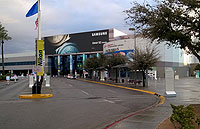 Yes, it’s that time o’ year – the Consumer Electronics Show in Las Vegas. Or as it’s known in my world, The Most Wonderful Time of the Year. This is Disneyland for Adults, with goodies and high-tech paraphernalia crammed into every connected nook and Smart cranny. The show used to be held at just the Las Vegas Convention Center, but it’s grown so large (170,000 visitors attended this year) that it’s now spilled over to fill up much of the nearby Sands Convention Center, as well.
Yes, it’s that time o’ year – the Consumer Electronics Show in Las Vegas. Or as it’s known in my world, The Most Wonderful Time of the Year. This is Disneyland for Adults, with goodies and high-tech paraphernalia crammed into every connected nook and Smart cranny. The show used to be held at just the Las Vegas Convention Center, but it’s grown so large (170,000 visitors attended this year) that it’s now spilled over to fill up much of the nearby Sands Convention Center, as well.
A few guidelines before we dive in.
First, I pretty much avoid the booths of the Big Guys. Companies like Samsung, Sony, Toshiba, Panasonic, Sanyo and the like. They are massive and sensory overload. And further, what one company has, the others do, as well. I do wander through, and if anything leaps out as slightly different, I’ll note it.
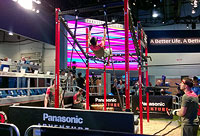 (Like, for instance, how surprisingly and bizarrely dismal the Panasonic area was. I don’t know what they were doing or trying to get across. It was a convoluted mess. They did have an acrobatic jungle gym, though.)
(Like, for instance, how surprisingly and bizarrely dismal the Panasonic area was. I don’t know what they were doing or trying to get across. It was a convoluted mess. They did have an acrobatic jungle gym, though.)
Also, there are several products I tend not to write about. Mainly TVs, cameras, mobile phones and cases. With TVs, the worst today are pretty darn good. And most are reasonably similar. Each differentiate themselves with jargon that is a) understood by no man, and b) meaningless, claiming they’re the best because they use proprietary Mezzo-Res Hi242 Attenuator technology, I have yet to figure out such things, and they all have their own versions. And if you want to know which one to buy, I always think the best answer is – ask your friends what they have and if they like it. As for cameras, most people use their mobile phones. Standalone cameras (especially video) do have value and differences, but quality is high among the names you know, and it’s the bells-and-whistles important to you that might make one more-worth considering. Mobile phones change by the week, and they’re dependent on your cellular service. Phone cases just scare me. (There are oceans upon oceans of them and ultimately…they’re cases. If you want a pink one with Hello Kitty, or your favorite baseball team logo, or that cool one with a built-in battery you’re on your own.)
The interesting thing is that this year I actually noticed a few intriguing tweaks in the fields of TV, cameras and mobile phones, so I’ll mention those when I get to it. (Not with cases. As I said, their over-abundance is dangerous and scares me.)
Oh, and I also won't be writing about Smartwatches because...well, there just wasn't all that much about them at the show. Perhaps at Apple’s big annual event they do a bigger dance over the iWatch. But right now, Smartwatches don’t seem to have yet grabbed the public’s fascination. Whether they will, or become a niche product remains to be seen. For a variety of reasons, I think more the latter. Most at least especially in the near-future.
Over the past few years, I also have written about the IFA Berlin tech show, and the two shows are similar. The difference seems to be that CES tends to feature tech products that you’ll see on the shelves during the coming months, while IFA is more about innovation in technology. Also, CES focuses more on what we think of as consumables tech, while IFA has a lot more with home appliances. To my surprise, I’ve come to appreciate the latter, whose innovation has become a fascinating field in tech, and a few things that made their way into CES. Another big difference between the two shows – half of IFA is in German. Bitte schoen.
And finally, and most of all, my annual warning ahead of time is that this will be long. I mean seriously looooooooooong. Not cute long, or longer than a normal column. I mean, “Oh, dear Lord, what is he thinking???” long. I spend days rambling around the show floors of two separate convention centers, and there is a LOT to cover. So, this will be really long. Seriously. So, if you don’t like long articles, don’t read any further. And don’t complain that it’s long. I know it is, I just told you. For those who do like such details, then buckle up your seatbelt, put on your crash helmet and let’s dive into the mass.
Here we go.
After every CES, I like to look back and try to figure what “theme” seemed to permeate the show that will give some indication of where tech is headed. It’s not always clear – the tech world always seems to need several years to catch up to itself, and so you often only get tweaks rather than some new direction. That seems to be the case this year, though a few themes did bubble up. Connected homes is one, and “Smart” seems to be ever-growing. (Pretty much anything these days is called “Smart” – just slap the word in front of your product and you’re all set.) But the larger point is that connecting devices to the Internet or to your Smartphones through apps is becoming even more pronounced than before, if that seems possible. Also, personal drones, Virtual Reality devices (VR) and 3D printers are growing as product lines. None seem imminent to break through just yet, and may never, but they’re worth keeping an eye on.
Once upon a time, there was another big tech show in Las Vegas, Comdex, which ran in November. It dealt almost exclusively with computers. That bit dust 13 years ago, and computers have been a small part of tech shows since. But there was somewhat of a resurgence this year, notably in the field of laptops and most particularly with convertibles or 2-in-1s. These are devices that, through a variety of different ways, can function as either a laptop or tablet. So, it’s nice to be able to write about the field again.
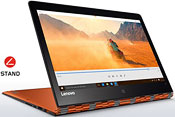 Lenovo has a seriously impressive convertible upcoming, the Yoga 900S. It’s incredibly thin and light – they claim the thinnest – only 2.2 pounds, that will retail starting at about $1,200. The touchscreen flips 360-degrees and turns the laptop into a tablet. It’s not the most powerful kid on the block, using an Intel Core-M chip for more battery life instead, rather in the faster “i” line (as in an i7 chip), but that’s fine for most people, if they’re not power users. I liked almost everything about it at early glance with one (unfortunate) caveat. The keyboard was painfully mediocre. The travel distance of the keys was very short and so I found it difficult to type extensively. Keyboards are subjective, of course, and for most people who do limited typing, I suspect the keys would be okay, and it seems a wonderful system – but since this column is at heart about writers, typing on the 900S keyboard for hours at a time was a deal breaker for my taste. That said, Lenovo also has a Yoga 900S Business Edition that’s near-identical (but with more security features), however it has a far superior keyboard. It weighs a bit more than its sister-system, but not much and at just 2.9 pounds is still very light. Pricing hasn’t been announced yet, though, and I’m sure it will be more than the regular 900S. A shame that they couldn’t both have had the same very good keyboards, but nice that there’s this option.
Lenovo has a seriously impressive convertible upcoming, the Yoga 900S. It’s incredibly thin and light – they claim the thinnest – only 2.2 pounds, that will retail starting at about $1,200. The touchscreen flips 360-degrees and turns the laptop into a tablet. It’s not the most powerful kid on the block, using an Intel Core-M chip for more battery life instead, rather in the faster “i” line (as in an i7 chip), but that’s fine for most people, if they’re not power users. I liked almost everything about it at early glance with one (unfortunate) caveat. The keyboard was painfully mediocre. The travel distance of the keys was very short and so I found it difficult to type extensively. Keyboards are subjective, of course, and for most people who do limited typing, I suspect the keys would be okay, and it seems a wonderful system – but since this column is at heart about writers, typing on the 900S keyboard for hours at a time was a deal breaker for my taste. That said, Lenovo also has a Yoga 900S Business Edition that’s near-identical (but with more security features), however it has a far superior keyboard. It weighs a bit more than its sister-system, but not much and at just 2.9 pounds is still very light. Pricing hasn’t been announced yet, though, and I’m sure it will be more than the regular 900S. A shame that they couldn’t both have had the same very good keyboards, but nice that there’s this option.
HP also had a couple of very good, new models, the Spectre X360 and Pavilion X2. Both are convertibles, with the Pavilion having a detachable screen allowing it to serve as a standalone tablet. They’re both over three pounds, though not by all that much. For most usage that’s okay, although for carrying around hours at a time at a trade show, I’ve found that three pounds is my outer limit.
 But then, even thin and light convertibles have been topped by the Kangaroo. This is an incredibly small computer. Basically it’s a small device about the size of two cigarette packs but thinner, with a detachable dock that has two USB ports. The device isn't terribly powerful – just 2 GB of RAM, an Atom processor and 32 GB of storage – but definitely serviceable. The point is that you can slip it in your pocket and take your computer anywhere. Then connect a keyboard and monitor to it, and you're fully set-up. With laptops so thin and light these days, and full-Windows 10 tablet, as well as Windows 10 Continuum devices on their way for Smartphones, its usefulness does not leap out it once might have, but it still has valuable use for many, and remarkably is only $99.
But then, even thin and light convertibles have been topped by the Kangaroo. This is an incredibly small computer. Basically it’s a small device about the size of two cigarette packs but thinner, with a detachable dock that has two USB ports. The device isn't terribly powerful – just 2 GB of RAM, an Atom processor and 32 GB of storage – but definitely serviceable. The point is that you can slip it in your pocket and take your computer anywhere. Then connect a keyboard and monitor to it, and you're fully set-up. With laptops so thin and light these days, and full-Windows 10 tablet, as well as Windows 10 Continuum devices on their way for Smartphones, its usefulness does not leap out it once might have, but it still has valuable use for many, and remarkably is only $99.
Speaking of Microsoft's new Continuum technology, I finally got to see it in operation. This is what lets Smartphones run like a real, full-featured Windows 10 computer (provided they are Continuum-capable). Right now, only the Microsoft Lumia 950 and its deluxe version (both of which do run on Windows 10) will allow for this, but more will come. The way this all works, there is a dock to which you connect your Continuum-enabled Smartphone, a keyboard and monitor. And then, bingo, you have real Windows 10 running. Not a lite-version, but it is a real, actual computer running Windows 10 in your pocket, that is your Smartphone. It was very impressive.
Another development in Smartphones that caught my eye – a rarity, as I noted above – is the Sony Z5 Premium. This is the first-ever 4K Smartphone. It shoots 4K videos and is able to play them back on the phone, and the videos were absolutely gorgeous. Breathtaking. At the moment, 4K has limitations in the world of television, no matter how much companies try to push it, because there’s limited content. But it works here. The phone sells for considerable coin, though, just under $700.
Related to this world of mobile, there was a device that I found particularly interesting, Karma. In fact, I put this in my small category of Cool Things. Every year after CES, people ask me “What cool things did you see at the show??!” And what they’re thinking are the big devices that have a lot of whizbang to them. But I find Cool Things to not be necessarily flashy at all, but something you use every day in a way that makes your life easier. And for me, Karma fits that. This is a small disk that lets you connect to WiFi wherever you are. The company has a deal with Sprint, which provides the cell connection that is then converted to Wi-Fi. You could be anywhere where there's no WiFi, in the middle of a park, or perhaps the desert – assuming it can pick up a cell signal – and you just log-in and connect. (The technology is most-suited for laptops and tablets which don't have cellular connections, rather than mobile phones that can access cellular on their own.) The device costs $149, and there are two options for data usage. Pay-as-you-go is $14 for a gigabyte of data – and there's no time limit, it never runs out. If you use half of that, you could toss it in a drawer and take it out three years later and go from there. Or you can pay $50 monthly for unlimited data. It seems a highly intriguing back-up protection for always having online access – though the company said that some people use it for all their connectivity, period.
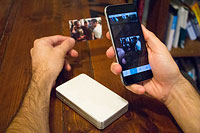 And one more mobile phone-related device caught my eye. LifePrint is a small, portable, wireless printer that will print photos directly from your phone. It uses either an iOS or Android app, and retails for $129. A pack of 50 sheets of printer paper costs $20. The resulting printouts are somewhat small (because the printer is), and I’m sure that most people can wait to print out the pictures they took, but there are times for some people where it would be helpful, if not important to have a photo printed on the spot.
And one more mobile phone-related device caught my eye. LifePrint is a small, portable, wireless printer that will print photos directly from your phone. It uses either an iOS or Android app, and retails for $129. A pack of 50 sheets of printer paper costs $20. The resulting printouts are somewhat small (because the printer is), and I’m sure that most people can wait to print out the pictures they took, but there are times for some people where it would be helpful, if not important to have a photo printed on the spot.
Cameras do have a great deal of overlapping similarity amongst themselves, as I mentioned, but Canon is stepping out from the pack with an 8K (!!) video camera, that’s in development. If 4K has its limitations today (though less so than with TV in the field of video cameras which can play back with 4K projectors), 8K ratchets up those limitations. In fact, Canon doesn’t have an 8K projector in development yet, only one that’s 4K. So, no matter how spectacular the 8K resolution, it will only be able to be shown at a much lower resolution. Certainly, an 8K projector will come, though at that point who knows where technology will be? But it’s important to innovate and push the technology.
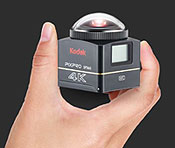 One other camera worth mention is the Kodak PixPro SP360 4K Action Cam. It’s an odd-looking little device – a small cube with a dome. But what sets it apart, in addition to being 4K resolution, is that it shoots in 360-degrees, either video or still photos. Kodak promotes it as being especially valuable when attached to a drone.
One other camera worth mention is the Kodak PixPro SP360 4K Action Cam. It’s an odd-looking little device – a small cube with a dome. But what sets it apart, in addition to being 4K resolution, is that it shoots in 360-degrees, either video or still photos. Kodak promotes it as being especially valuable when attached to a drone.
 I have no idea how big the drone market will get. It might be a passing fad for home use as a toy – but I think not. There are too many companies showing them at CES (like DJI, AEE, 3DR and many more), and they’re clearly too high-end. It seems like business application will be their most significant use, but it’s a developing field.
I have no idea how big the drone market will get. It might be a passing fad for home use as a toy – but I think not. There are too many companies showing them at CES (like DJI, AEE, 3DR and many more), and they’re clearly too high-end. It seems like business application will be their most significant use, but it’s a developing field.
This is somewhat the same with 3D printers. I was inundated with press releases for them before the show, and they seemed to pop up everywhere. Ubiquitous as they were, I still don’t get the sense that they’re showing a capability that the general public is crying out for. But the prices have come down so significantly from recent years that the business market seems ripe for growth.
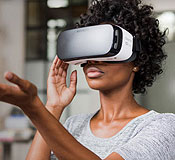 In an odd way that sort of overlaps my feeling about Virtual Reality, which has been proclaiming it’s the Next Big Thing for the past three years. It did get a massive push at this year’s show with the oft-delayed and highly-anticipated Oculus Rift finally – finally! – having a booth. I was curious enough to consider standing in line for the demo, something I rarely do, but when I saw that the line was so long that I’d probably just now be getting to the front, I gave up and walked away. But this certainly does speak to consumer interest. There were other companies pushing their VR, as well, though what I’ve seen at this early point has never done much for me, mostly gimmicky and an expanded way to have 3D with games. That’s certainly a very big market, but not something that these adopters will move beyond – though Oculus Rift may well be that breakthrough, allowing for a far-more immersive experience and capability. The much greater potential seems to be for expanding into business applications, notably medicine and engineering. Of all the VR out there, my sense is that Microsoft’s upcoming HoloLens is by far the most intriguing challenge to Oculus Rift.
In an odd way that sort of overlaps my feeling about Virtual Reality, which has been proclaiming it’s the Next Big Thing for the past three years. It did get a massive push at this year’s show with the oft-delayed and highly-anticipated Oculus Rift finally – finally! – having a booth. I was curious enough to consider standing in line for the demo, something I rarely do, but when I saw that the line was so long that I’d probably just now be getting to the front, I gave up and walked away. But this certainly does speak to consumer interest. There were other companies pushing their VR, as well, though what I’ve seen at this early point has never done much for me, mostly gimmicky and an expanded way to have 3D with games. That’s certainly a very big market, but not something that these adopters will move beyond – though Oculus Rift may well be that breakthrough, allowing for a far-more immersive experience and capability. The much greater potential seems to be for expanding into business applications, notably medicine and engineering. Of all the VR out there, my sense is that Microsoft’s upcoming HoloLens is by far the most intriguing challenge to Oculus Rift.
A technology that manipulates reality, as well, but in a very different way is one that I’ve written about for almost half a dozen years, and this appears to be their breakout year, as well, finally having come to market a month or so ago. And that’s the Ultra-D technology from Stream TV Networks. This is a product that allows for 3D TV without requiring glasses. I’ve seen it in operation, and the result is quite remarkable. Also, not only does it get rid of the biggest impediment of early attempts at 3D TV – not needing glasses – but it solves the content issue, as well. That’s because Ultra-D can convert any live TV to 3D in real-time. (Sports look especially good on it, and the company is in talks with the NFL, NBA and others.) And not just 3D content, but it solves the lack of 4K content issue, too. Sets that use Ultra-D are 4K, and the technology can convert standard content to 4K-like resolution. Furthermore, it’s in gaming that the glassless 3D may even shine the most. Numerous games have already been produced, and Stream TV Networks is working with the two leading companies who make the gaming engines for 80-85% of all developers. One game they had a demo for, I believe it was called something like Tank Wars, had some of the most remarkable 3D without glasses I’ve seen.
And as I said, they’ve finally come to market, with sets from a Florida company, Izon, and other companies are scheduled to have their sets on sale by the summer. (The Ultra-D technology is licensed to TV manufacturers.) They've already sold sets to Duke University for medical use, and Florida State University film department. (Read the effusive blog posting about it from Duke’s Head of Technology here. It begins with a standalone paragraph, “Wow.”) And in conjunction with their partner Inception Visual who works with AT&T, the company is running tests with many AT&T clients. But what's also interesting is their development of glassless 3D monitors, signage, and tablets, the latter of which could be an even bigger market than TVs – allowing people to watch movies and play games in 3D on the road without being tethered to needing 3D glasses or VR goggles – and developing too is their full mobile field, including Smartphones. So, the Ultra-D technology is finally beginning to reach a level of public viability and maturity, even if it hasn't quite broken through yet.
Of course, when it comes to the world of standard television technology, the forests of TVs are one of the fields that, as I noted above for several reasons, I just tend to avoid.
That said, this year more than most, certain things did surprisingly stand out in TV Land. And what stood out most is what wasn’t there. Last year, TV companies went to massive lengths trying to convince you that “curved screens” would make your TV-viewing lives oh-so much better. I explained at the same time that curved screens were largely a marketing gimmick. Well, reality seems to have caught up, and it was remarkable how few companies were pushing curved screens – at all. Some did display them, though without the fanfare. But at the huge LG booth, I didn’t even see a single curved screen. There might have been a few, but if so they were buried amidst what else was there, and new.
And what was new amongst most of the TV companies did stand out as valuable this year, unlike curved screens. First and foremost was the expansion of OLED screens. It wasn’t long ago that OLED got introduced for its impressive high resolution, but it was so expensive that you only saw OLED screens on small devices, like high-end Smartphones. But times change, and now OLED has hit the bigtime, even on screens up to 77”. And the quality is tremendous. So is the prices, which is very expensive, but at least at a level now that justifies general consumer release.
And improving quality even further is something called HDR, or High Dynamic Resolution, which booths like LG was trumpeting. The easiest way to describe this is that it’s not giving you more pixels but making the individual pixels better. Like giving each pixel more contrast. And convoluting the issue is the Quantum Dot, which Samsung and others displayed (and in that whimsical jargon way TV manufacturers oh-so love, some instead call it “nano-crystal semiconductors” or whatever other mellifluous phrase) – basically this brings a more intense, bright, clear light to the pixels. I know the technologies are different, but the concepts struck me as in the same ballpark, and the end results of what consumer see are similar. And unlike some technologies, the improvement in resolution was evident.
With OLED screens and HDR or Quantum Dot with LCD screens, resolution even on standard 1080p sets was stunning. Almost at 4K level. (Almost.) And on 4K sets, showing 4K video, the resolution was…well, at 4K level. Even a touch higher, it seemed. But as I’ve said, as much as TV companies are still aggressively pushing 4K, there is almost no native 4K content that can be played on a 4K TV. So, while you’re getting the benefits of HDR or Quantum Dot, you aren’t getting too much of anything for the 4K part. Think of it this way – you have the world’s greatest quadraphonic 4-speaker Dolby sound system, but quadraphonic recordings haven’t been invented yet, only one-channel mono. One day, there will be native content for 4K sets, though at that point, who knows where TV will have developed. But be comforted knowing that there really is a significant breakthrough in quality with OLED and with whatever you call HDR or Quantum Dot.
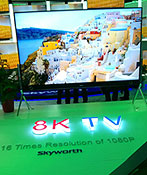 (Just so you know I’m not totally speaking out of my hat about that “where TV will have developed” thing: some companies, like Skyworth, are already starting to promote upcoming 8K sets! 4K hasn’t even gotten off the ground yet – and with little to no content. All the more to the point of over-paying for something to anticipate the future, while not knowing what the fast-changing future holds.)
(Just so you know I’m not totally speaking out of my hat about that “where TV will have developed” thing: some companies, like Skyworth, are already starting to promote upcoming 8K sets! 4K hasn’t even gotten off the ground yet – and with little to no content. All the more to the point of over-paying for something to anticipate the future, while not knowing what the fast-changing future holds.)
By the way, let’s make this more fun: Quantum Dot technology generally uses cadmium. Alas, at very high levels, cadmium is toxic. Not that the trace level is high enough inside a TV set, and additionally components are sealed, but some manufacturers are now promoting “cd-free” Quantum Dot sets, which are instead made with indium. (The public concern is less about home-use levels, but in landfills where high levels of old thrown-away sets would concentrate.) Two issues: indium is less efficient, not just with the resulting image, but with environmental emissions – and it appears to also be toxic.
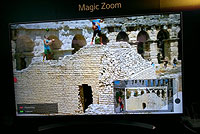 General TV improvements (and issues…) aside, I did spot a few individual features that I thought were quite nice. One was LG’s “Magic Zoom.” This lets a viewer use the remote to highlight any portion of the screen, and then enlarge just that selected area. And LG’s “Channel Plus” feature allows for streaming websites to be built into your set, and create Favorites. Somewhat similar, the Haier company has the popular Roku service (for streaming the Web) built directly into their televisions, allowing you to switch between regular TV channels and streaming sites.
General TV improvements (and issues…) aside, I did spot a few individual features that I thought were quite nice. One was LG’s “Magic Zoom.” This lets a viewer use the remote to highlight any portion of the screen, and then enlarge just that selected area. And LG’s “Channel Plus” feature allows for streaming websites to be built into your set, and create Favorites. Somewhat similar, the Haier company has the popular Roku service (for streaming the Web) built directly into their televisions, allowing you to switch between regular TV channels and streaming sites.
(And I’m sorry, but every time I write about this, how TVs today integrate the Internet in them – and how TV networks all stream online – I’m reminded how just a few years ago, the WGA was pushed into going on strike because the corporate-owned AMPTP insisted with a straight face or without their noses growing that it just didn’t know at all what the future was with that strange Internet thing, and if there could possibly be any money in it. And yes, reports are that their pants are indeed on fire…)
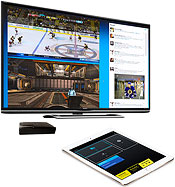 I also thought a TV-related product called Skreens showed promise. At first it struck me as a gimmick, but I eventually saw a value for some people. This is a controller box that connects to your TV through the HDMI port and lets you split the television screen into separate windows. It’s not for everyone, but there are a whole lot of people who multi-task when watching television, and this can put the TV feed in one box, your Internet browser in another, an Xbox game into a third box, and your email in the fourth, accessible all at the same time. You can switch between which you want to have priority and sound. The company makes two models, 2-port (for $250) and 4-port (for between $450-500) – though I think if one has an interest in this, then it defeats the purpose to only allow two devices, and the 4-port is the way to go.
I also thought a TV-related product called Skreens showed promise. At first it struck me as a gimmick, but I eventually saw a value for some people. This is a controller box that connects to your TV through the HDMI port and lets you split the television screen into separate windows. It’s not for everyone, but there are a whole lot of people who multi-task when watching television, and this can put the TV feed in one box, your Internet browser in another, an Xbox game into a third box, and your email in the fourth, accessible all at the same time. You can switch between which you want to have priority and sound. The company makes two models, 2-port (for $250) and 4-port (for between $450-500) – though I think if one has an interest in this, then it defeats the purpose to only allow two devices, and the 4-port is the way to go.
With all the explosion in capabilities that TV sets have today, it’s not surprising that the once-lowly TV remote is ratcheting itself up, as well. Universal remotes that control not just your TV, DVR, DVD player, Xbox, lights, stereo system, and other household devices have long been prevalent. I do think there’s a limit to how much you should be swayed with how many devices it can control – after all, if you use it to control the boombox upstairs, the clock-radio in your bedroom, and the microwave in the kitchen, that means you have carry it with you all over. And people have a hard enough time trying to find the remote when it simply stays in the living room. Imagine not knowing what room of the house it’s in! One vendor of the excellent and elegant NEEO remote tried helpfully to suggest that if you had 10 rooms, you could buy one for each room. “Sure,” I said, of the $349 device, “and it will only cost you $3,500.” To her credit, she burst out laughing and agreed. But in fairness, the NEEO is terrific, and several other remotes too had features that stood out. The Savant, for instance, is voice controlled, something I haven’t seen elsewhere. Though it’s a wee pricey at $499. The Ray Super Remote, an Innovation Awards winner at the show, was impressively configured with an LCD screen that conveniently breaks down shows into categories, like Comedies, Sports, and Kids, as well as Favorite Movies, along with an All Channel Guide, and it includes letting you set up reminders. It retails for a comparatively-reasonable $249.
Ah, all those household appliances connected by a single remote. In some ways, that’s at the very heart of another of the Big Themes at the show this year (and last year, as well, though this year it had developed to the degree of almost coming across as matter-of-fact, taken for granted), the Connected Home. The concept is basically centered on the idea of devices connected to the Internet that you can operate through apps on your Smartphone or tablet.
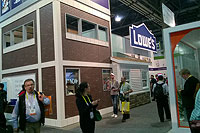 In some cases, we’re talking about literally the whole home. There was a massive area for just this at the Sands Convention Center, with companies displaying models of homes set up fully connected. Companies like Bosch, Honeywell, Elgato, Okom, iControl and many, many more. Common items are 2-way remote controls for lighting and heating, cameras that let you keep watch on your children or pets (interesting how the two are considered similar…), motion detectors, monitors that improve air quality and much more.
In some cases, we’re talking about literally the whole home. There was a massive area for just this at the Sands Convention Center, with companies displaying models of homes set up fully connected. Companies like Bosch, Honeywell, Elgato, Okom, iControl and many, many more. Common items are 2-way remote controls for lighting and heating, cameras that let you keep watch on your children or pets (interesting how the two are considered similar…), motion detectors, monitors that improve air quality and much more.
While the basic concept of connected homes using mobile devices and apps is fairly standard,, there are some offbeat adaptations which go in their own unique directions.
Singlecue, for instance, uses hand motion for control of connected home devices. It’s certainly a futuristic, fresh option, though I’ve had qualms about hand-motion since it started being pushed a few years back. You not only have to learn the commands, which might compete with other hand-commands you have for other devices, but I’m not sure how to solve the problem of pesky children playing around with waving their hands to see the lights and TV go on-and-off.
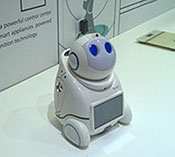 Then there’s the Skyworth Canbot. This a robot control center for Smart appliances, powered by speech recognition. I have no idea if it’s practical or will work. Maybe so. But it certainly will get you lots of comments. Like, what would it look like if R2D2 got married and had a baby?
Then there’s the Skyworth Canbot. This a robot control center for Smart appliances, powered by speech recognition. I have no idea if it’s practical or will work. Maybe so. But it certainly will get you lots of comments. Like, what would it look like if R2D2 got married and had a baby?
Related to all this is an idea from Home Advisor. It’s what they call a “digital marketplace for the connected home.” Basically, the service uses a free app that helps you connect to professional repairmen if you need work done in your home in 30 different categories. The company goes through extensive background checks to sign up the professionals (who pay a monthly fee to be part of the service), and user reviews let you decide who to contact. Through the app, you can search for your specific need, see the technicians’ calendar and set up an appointment.
LG’s entry into connected homes is with what they called Smart ThinQ. (I’m guessing that’s cleverly-pronounced “Think.” As opposed to “Thin Q.” To which the proper response is probably “You’re welcome…”) It doesn’t appear to be so much a traditional “connected home,” but a stylish line of Smart appliances that are controlled by WiFi – your lights, heating, washing machine, oven, dishwasher and more. My notes say that you can also check your messages and use integrated Bluetooth speakers, though it’s possible at that point I was beginning to hallucinate. I do know that they said the Smart ThinQ line does not include the kitchen stove, for safety reasons – turning on burners remotely when others aren’t aware probably wouldn’t be the greatest idea.
There was also a profusion of individual home appliances which could be considered part of a connected home. Some certainly are “smart” and all definitely are core to the home, but they struck me as part of their own, fascinating universe.
This is what I was referring to at the very beginning, about the some of the most clever innovation I saw at the show, an extension of what’s so prominent at IFA Berlin, but on a much smaller scale over here. (A lot of what is at IFA isn’t even available in the U.S., at least yet.)
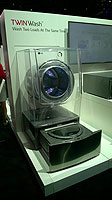 For instance, LG has a double washing machine, the TwinWash, which allows you to do two different kinds of loads at the same time. They also introduced the “Styler,” which is a sort of closet-like device that lets you steam clean your clothes.
For instance, LG has a double washing machine, the TwinWash, which allows you to do two different kinds of loads at the same time. They also introduced the “Styler,” which is a sort of closet-like device that lets you steam clean your clothes.
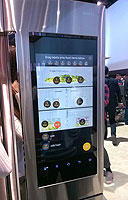 One of the more innovative home appliances I saw was a Smart refrigerator from Samsung. (Yes, a refrigerator. And yes, it’s Smart.) These had LED panels on the doors which let you see what was inside the fridge without having to keep opening the doors, using inside cameras. But the greater value of the interior cameras comes when you’re out at the grocery store – an app lets you check back home inside your refrigerator to see if you need anything. Additionally, you can order foods you're low on right from the refrigerator door, connecting to online stores through the touchscreen. It also offers up recipes and displays when a food’s freshness might expire. And there are speakers in the doors, for streaming music, I would imagine. And…no, it’s not available in the U.S. yet.
One of the more innovative home appliances I saw was a Smart refrigerator from Samsung. (Yes, a refrigerator. And yes, it’s Smart.) These had LED panels on the doors which let you see what was inside the fridge without having to keep opening the doors, using inside cameras. But the greater value of the interior cameras comes when you’re out at the grocery store – an app lets you check back home inside your refrigerator to see if you need anything. Additionally, you can order foods you're low on right from the refrigerator door, connecting to online stores through the touchscreen. It also offers up recipes and displays when a food’s freshness might expire. And there are speakers in the doors, for streaming music, I would imagine. And…no, it’s not available in the U.S. yet.
Though not “Smart” (but clever…) and in fact the very opposite of connected, the GoSun Grill was a very different kind of home appliance – a solar outdoor grill. It heats up to 400-degrees, and will work under most any conditions, other than of course nighttime (though you can hook it up to electricity for that.) They claim it can cook a full meal for eight pretty quickly, in an hour. The company makes two models – a portable 2-person Sports Grill for $279, with no electric capability, and the family model for $599.
Actually, Smart devices are a world of their own at CES. There’s a fine line between them and the “connected home” (or Smart home appliance) concept just discussed, but the distinction I make is that a Smart device tends to be more of a standalone personal product, and not intended as part of an “integrated pie” that’s central to the household. And as I mentioned at the beginning, it too was one of the major themes at the show. Put “Smart” in front of your product’s name, and you’re all set to go to market.
Some of Smart products were admittedly a bit odd. The Ember Smart Mug lets you adjust the temperature of your beverage or soup and keep it constant – for only $129. The Enko Smart running shoes adapt themselves to the weight of the user, and can adjust to whether you’re running or walking. And Toto has a Smart toilet, the Neorest. (Hey, if it was really smart, it wouldn’t be a toilet…) It opens automatically, flushes automatically, and has a bidet built in, so there’s no need for using paper, and it’s an energy saver. Quips aside, it’s high-end and very well-made.
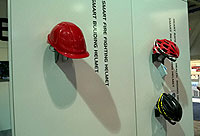 Which brings us to one of the oddest Smart devices, a Smart helmet (really). But the thing is, the more I learned about it, the more it became another of the Cool Thing Award winners for me. Really. At first glance, it’s just a line of helmets – construction worker helmets, fireman helmets, bike rider helmets. But not only did they turn out to be Cool Things, but the New Zealand company, Babaali, came up with one of the first actually valid uses I’ve seen for Google Glasses (the strange devices that, among other things, let you browse the Internet in the frames and make you look like a Star Trek Borg.) The helmets are Bluetooth-enabled, letting a construction worker or firefighter make phone calls without having to fumble with their hands, when they might have, say, something far more important to do with them. (It also allows for streaming music, to help pass the time…). As for the bike helmets, the Google Glass not only lets you check maps to navigate, but more importantly provides for being able to look behind you (!) while keeping your eyes looking forward. There are more features, as well, like turn signals. The most basic models retail for $99, but the more elaborate helmets can reach $600.
Which brings us to one of the oddest Smart devices, a Smart helmet (really). But the thing is, the more I learned about it, the more it became another of the Cool Thing Award winners for me. Really. At first glance, it’s just a line of helmets – construction worker helmets, fireman helmets, bike rider helmets. But not only did they turn out to be Cool Things, but the New Zealand company, Babaali, came up with one of the first actually valid uses I’ve seen for Google Glasses (the strange devices that, among other things, let you browse the Internet in the frames and make you look like a Star Trek Borg.) The helmets are Bluetooth-enabled, letting a construction worker or firefighter make phone calls without having to fumble with their hands, when they might have, say, something far more important to do with them. (It also allows for streaming music, to help pass the time…). As for the bike helmets, the Google Glass not only lets you check maps to navigate, but more importantly provides for being able to look behind you (!) while keeping your eyes looking forward. There are more features, as well, like turn signals. The most basic models retail for $99, but the more elaborate helmets can reach $600.
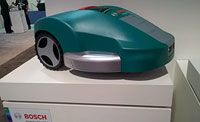
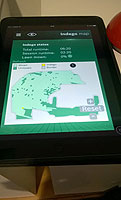 In fact, another Cool Thing Award went to yet another odd, but Smart device, the Bosch Indego Connect. This is a Smart lawn mower that doesn't need anyone operating it. You install an electric wire underground around your property, and it learns your boundaries. Then you use an app to choose the settings you want – what day, the time, weather conditions and so on, there are many – and it mows on its own. The Indego Connect (why that name, I have no idea) even knows that when it's low on power, to go back to the docking station and recharge, which takes about 50 minutes, and then return to where it left off and continue on from there. And it knows where it’s already mowed, so it won’t duplicate an area. And no, alas, it’s not available in the U.S. It costs around $1,200.
In fact, another Cool Thing Award went to yet another odd, but Smart device, the Bosch Indego Connect. This is a Smart lawn mower that doesn't need anyone operating it. You install an electric wire underground around your property, and it learns your boundaries. Then you use an app to choose the settings you want – what day, the time, weather conditions and so on, there are many – and it mows on its own. The Indego Connect (why that name, I have no idea) even knows that when it's low on power, to go back to the docking station and recharge, which takes about 50 minutes, and then return to where it left off and continue on from there. And it knows where it’s already mowed, so it won’t duplicate an area. And no, alas, it’s not available in the U.S. It costs around $1,200.
I think this is a good place to have an intermission, and let you take a break, perhaps stretch your legs, go to the bathroom, maybe have a bite of food to build up your strength. Don’t worry, this isn’t the halfway point – happily we’re far beyond that – but there’s still a little ways to go. And don’t worry, we’ll wait for you while you relax a bit. Take a nap, if you like.
In the meantime, for those who stick around, I thought I’d fill in the time with a tale that occurred on my first day at CES, before the doors to the show floor officially opened the next morning.
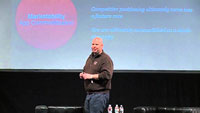 I had registered and went to a press conference, afterwards wandering off, when I spotted a fellow I knew who’s in charge of the excellent Showstoppers press event held at the show every year. We chatted, and he was with a few other people, so I had an odd, fun exchange with one of them. We were chatting along, and he seemed a nice fellow. Since it was Press Day, I got around to asking who he wrote for. He said he didn’t write for anyone, he was just a tech nerd. Later, he talked a bit about what he did, so I asked if he was sort of a management consultant. “Not exactly, I give my advice and people like being attached to my brand.” His brand? Well, fair enough. Eventually, he offhandedly mentioned that he helped create the iPhone. Oh! Ha! Okay, well, yeah, that was different. Andy Grignon. I looked him up online, and sure enough, he was the Senior Manager on the development team.
I had registered and went to a press conference, afterwards wandering off, when I spotted a fellow I knew who’s in charge of the excellent Showstoppers press event held at the show every year. We chatted, and he was with a few other people, so I had an odd, fun exchange with one of them. We were chatting along, and he seemed a nice fellow. Since it was Press Day, I got around to asking who he wrote for. He said he didn’t write for anyone, he was just a tech nerd. Later, he talked a bit about what he did, so I asked if he was sort of a management consultant. “Not exactly, I give my advice and people like being attached to my brand.” His brand? Well, fair enough. Eventually, he offhandedly mentioned that he helped create the iPhone. Oh! Ha! Okay, well, yeah, that was different. Andy Grignon. I looked him up online, and sure enough, he was the Senior Manager on the development team.
We talked about Steve Jobs a bit, and he was blunt. I’ll keep most of that private, since it was a private conversation, but from what I came across online he’s been very upfront in other interviews, so it’s not breaking any confidences to note that he said about his former boss, “He was an asshole” – but it wasn’t with even the slightest bitterness, just as a point of description. (Indeed, he said that he himself was pretty much a jerk himself until he stopped working at Apple, “That’s when I was able to become a nice guy.”) It was all very genial, lots of smiles, zero rancor. Sort of, hey, that’s who Steve Jobs was, so be it. He didn’t care much for the recent Jobs movie, but not specifically because he felt it was unfair, but rather because “Hollywood has to overly-dramatize these things, and really what we did was kind of boring.” Anyway, I’ll leave it at that.
And now, back to the show…
Okay, so what would a tech column from me, at a huge trade show no less, be without extensive mention of portable chargers? As I’ve oft-explained, I have this love of such devices for no fully understandable reason, though it has to do with the clever utility of multipurpose design. So, at CES I was in heaven. Amid the mountains of devices, a few products stood out.
The company myCharge has a new line of interesting-looking chargers, but what most caught my eye was the RazorUltra-C with Power Delivery. This is a stylish, small (fitting in your pocket) device that holds a large 13,400 mAh charge, yet is very reasonably light, and most importantly will also let you charge not just mobile phones and tablets, but also any laptop that comes with the new USB-C port (such as the new MacBooks, or the Lenovo Yoga 900S). This means that you will no longer have to carry around bulky power blocks if you travel. There’s also a built-in temperature gauge which will shut down the charger if it gets too hot. It will retail for $100 when it hits the market.
(Quick note. Most people know about USB plugs. The standard are those half-inch long USB-A plugs, though most mobile devices use the smaller micro-USB. Apple is a different, accepting the Lightning plug for the iPhone and iPad. Coming this year, however, is a new standard that pretty much everyone will soon be adopting, the above-mentioned USB-C, also known as USB Type-C. This is about the same size of micro-USB, but the plug is reversible, meaning it can go in either direction. It also allows for faster speed transfers and more power. I don’t know if Apple mobile devices will adopt it, but Apple is for their laptops. There are reports that Apple is testing USB-C on its next iPhone, but that’s totally uncertain. Given that Apple only recently switched to the Lightning plug, it makes the decision all the more meaningful. By the way, USB-C is backwards compatible, so if you have an adapter for your micro-USB plugs they’ll still work in a USB-C port. End of quick note. Back to portable chargers…)
TYLT will soon be releasing an upgrade that has strong improvements to its excellent VU wireless charger that uses the Qi standard. It will have an additional coil for faster charging, better positioning when you place your device to charge, and a more convenient angled design.
 And GoalZero – an outdoor-based wilderness company which includes a wide lineup of solar chargers – has quite a few impressive additions. The Lighthouse Mini is an even-more portable version of the original. It’s a dimmable lantern that can run for 500 hours on the low setting, and doubles as a power charger, with foldable legs than can become a hook for hanging. It retails for $60.
And GoalZero – an outdoor-based wilderness company which includes a wide lineup of solar chargers – has quite a few impressive additions. The Lighthouse Mini is an even-more portable version of the original. It’s a dimmable lantern that can run for 500 hours on the low setting, and doubles as a power charger, with foldable legs than can become a hook for hanging. It retails for $60.
 GoalZero is also moving into a more “general consumer” line through their parent company, NRG. I was very impressed with their Sunbook 7 Kit (made for Smartphones) and the larger Sunbook 14 (for tablets). It’s an all-in-one package that has a solar panel with fold-out legs, and a storage battery – connected to the solar panel to charge it – that sits in a convenient pocket, though it’s removable. The kit is designed very elegantly and conveniently for the general public, rather than backpackers. The Sunbook 7 battery is 3850 mAh (enough for almost two charges of a Smartphone), while the battery for the Sunbook 14 is 12,000 mAh. By the way, that stands for “milliampere.”
GoalZero is also moving into a more “general consumer” line through their parent company, NRG. I was very impressed with their Sunbook 7 Kit (made for Smartphones) and the larger Sunbook 14 (for tablets). It’s an all-in-one package that has a solar panel with fold-out legs, and a storage battery – connected to the solar panel to charge it – that sits in a convenient pocket, though it’s removable. The kit is designed very elegantly and conveniently for the general public, rather than backpackers. The Sunbook 7 battery is 3850 mAh (enough for almost two charges of a Smartphone), while the battery for the Sunbook 14 is 12,000 mAh. By the way, that stands for “milliampere.”
Not all elegant and wonderfully-designed tech necessarily makes for a successful product. For instance the Echobox is a beautiful, very high-end music player (shaped like a hip flask). Unlike most music players, it can accept high-end headphones. It has well-thought out controls and convenient categories. Clearly, the well-built player is made for audiophiles. I’m just not sure if even audiophiles are looking for a music player, period, let alone one that is expected to cost $500. My sense is that most people, even audiophiles, are just fine with using their Smartphone when on the road, and when they want the best-sounding music at home, they have a stereo system ready. Maybe not, maybe there’s a niche market for this. It’s a really nice device. But…
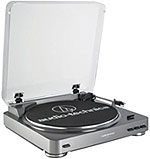 On the other hand, I came across a very basic turntable for LPs from Audio-Technica which you might think would be at the other end of the sound spectrum. Something reasonably inexpensive at $179 that most people don’t have a need for. But again, the more I considered it, the more I realized that this was another Cool Things Award winner. (It’s an odd occurrence this year how many Cool Things started off at first glance as uninteresting.) The AT LP60 BT – Audio-Technica consistently makes very good products with really lousy names…is nothing more than a standalone turntable. What made this so intriguing is that it has Bluetooth capability. So what, I hear you cry? Well…you see, usually when one has old LP albums sitting around they go un-listened to for several reason – the person has no turntable, or no full system set-up with a turntable connected to a receiver and big floor speakers. Nor the space for it all in the living room. But with this Bluetooth turntable, you don’t need to connect it to…well, anything. You could just plug it in and stick it anywhere, even in a closet if you wanted to. And then with its Bluetooth capability, it will send the audio to any Bluetooth speakers you have (including, of course, small portable ones on your desktop), or to your Bluetooth headphones. As the company spokesman noted, this turntable takes one of the least portable audio devices there is and makes it portable. And bizarrely, it sort of does. But mainly, it makes old LP collections exceedingly usable once again.
On the other hand, I came across a very basic turntable for LPs from Audio-Technica which you might think would be at the other end of the sound spectrum. Something reasonably inexpensive at $179 that most people don’t have a need for. But again, the more I considered it, the more I realized that this was another Cool Things Award winner. (It’s an odd occurrence this year how many Cool Things started off at first glance as uninteresting.) The AT LP60 BT – Audio-Technica consistently makes very good products with really lousy names…is nothing more than a standalone turntable. What made this so intriguing is that it has Bluetooth capability. So what, I hear you cry? Well…you see, usually when one has old LP albums sitting around they go un-listened to for several reason – the person has no turntable, or no full system set-up with a turntable connected to a receiver and big floor speakers. Nor the space for it all in the living room. But with this Bluetooth turntable, you don’t need to connect it to…well, anything. You could just plug it in and stick it anywhere, even in a closet if you wanted to. And then with its Bluetooth capability, it will send the audio to any Bluetooth speakers you have (including, of course, small portable ones on your desktop), or to your Bluetooth headphones. As the company spokesman noted, this turntable takes one of the least portable audio devices there is and makes it portable. And bizarrely, it sort of does. But mainly, it makes old LP collections exceedingly usable once again.
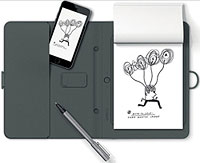 Taking something basic and “old world” and moving it into high-tech is also what’s behind Wacom’s Bamboo Spark. (Yet another interesting product whose name I don’t grasp…) This is a device that converts your handwritten text or notes to digital. I’ve written about products like this in the past, but they’ve all failed for different reasons – either they work effectively, but are much too convoluted to set up, or they require proprietary paper which makes use problematic and prohibitively expensive. The Bamboo Spark appears to resolve all that. For starters, it can work with any paper (as long as the pad isn’t too thick). And as for simplicity, this is a folio with a placeholder on the left for your tablet or Smartphone, a digitizer pen, and your paper sits on the right. Basically – press a button, write, and press the button when you’re finished. If your tablet is connected, it will transfer the converted digitized content immediately. If you your tablet/phone isn’t connected, the pen will save the content until you do connect. How well it works, I don’t know. The demo worked well. I got the sense that it’s most effective for short note-taking, rather than writing out long treatises, but I have no idea if that’s a valid observation. It bears looking into. The retail price is $160.
Taking something basic and “old world” and moving it into high-tech is also what’s behind Wacom’s Bamboo Spark. (Yet another interesting product whose name I don’t grasp…) This is a device that converts your handwritten text or notes to digital. I’ve written about products like this in the past, but they’ve all failed for different reasons – either they work effectively, but are much too convoluted to set up, or they require proprietary paper which makes use problematic and prohibitively expensive. The Bamboo Spark appears to resolve all that. For starters, it can work with any paper (as long as the pad isn’t too thick). And as for simplicity, this is a folio with a placeholder on the left for your tablet or Smartphone, a digitizer pen, and your paper sits on the right. Basically – press a button, write, and press the button when you’re finished. If your tablet is connected, it will transfer the converted digitized content immediately. If you your tablet/phone isn’t connected, the pen will save the content until you do connect. How well it works, I don’t know. The demo worked well. I got the sense that it’s most effective for short note-taking, rather than writing out long treatises, but I have no idea if that’s a valid observation. It bears looking into. The retail price is $160.
Staying in the world of accessories, the Ditto is likely of little use for most people, but for those who are highly-connected to their mobile devices or social media, always having to check your Smartphone every minute likely wears thin. The Ditto (which is shaped like a pebble, about the size of your thumb) lets you set up very basic alerts for, say, texts from specific individuals, or email or Facebook posts from people you want to stay in immediate touch with, or when you get a contact from a dating app, or a very important call you’re expecting. The Ditto will vibrate when one of your configurable alerts comes in. So, you’ll only have to take out your phone at those times, not check it every minute. It costs $40. There’s one strange design side to it – they only made it to wear, like clip to your clothes (which isn’t ideal for most people) or sit in your pocket (where it can be easily lost). I suggested to a company rep that for the next upgrade they might want to consider a little pinhole that would allow you to slip it onto your key chain. “What a great idea!” she said. Yes, I know…
 Small and portable doesn’t have to be simple and basic, of course. And I came across a product which I normally wouldn’t write about, but I was so taken by how valuable it was that it deserves inclusion. It was another CES Innovations Awards winner, and not for the general consumer market, but rather the medical field. MyECG is a wireless, portable, pocket electro-cardiogram! It connects to a Smartphone with Bluetooth. I suspect it’s mostly for doctors, but also likely has important value for heart patients at risk, whose doctors might want them to be able to check their vital signs when necessary. But impressive as the product is, what I almost loved the most is the odd “available soon” price listed on its website – $378.08. I have no idea who came up with that amount or why. But I’d like to give them a hug.
Small and portable doesn’t have to be simple and basic, of course. And I came across a product which I normally wouldn’t write about, but I was so taken by how valuable it was that it deserves inclusion. It was another CES Innovations Awards winner, and not for the general consumer market, but rather the medical field. MyECG is a wireless, portable, pocket electro-cardiogram! It connects to a Smartphone with Bluetooth. I suspect it’s mostly for doctors, but also likely has important value for heart patients at risk, whose doctors might want them to be able to check their vital signs when necessary. But impressive as the product is, what I almost loved the most is the odd “available soon” price listed on its website – $378.08. I have no idea who came up with that amount or why. But I’d like to give them a hug.
By the way, after reading about all these products here, you might be inclined to purchase some online, which always raises the specter of online fraud. We’ve read about the new credit cards with built-in security chips. A company called uQontrol has come up with a related product for online shopping, Qkey. This is a device like a Flash drive with its own chip technology. You put it into a USB port – and after providing security codes to log in, you enter your own credit card information, favorite online stores and such. It has its own proprietary browser that lets you access the shopping sites. When you’re finished, you log out and remove the Qkey. It leaves no footprint behind, so you can carry it with you on a keychain and use it on any computer.
Of course, you might prefer to do your shopping in good, old brick-and-mortar stores, in which case you’ll need a way to get around. Beyond the growth of electric cars, there appears to be an increasing market in other electric transportation, including scooters.
Gogoro, from Taipei, has an extremely impressive electric scooter – sorry, SmartScooter, that can reach 60 MPH. The battery cells are built by Panasonic, and you can either swap them out when low, or charge them at home or – in a unique business plan – at shops with which Gogoro has partnership deals. (The concept being that it’s in a store’s interest to provide charging outlets to bring in business.) Currently, there are 70 such GoStations in the Greater Taipei area, which currently is the only place they’re being sold for between $3-4,000.
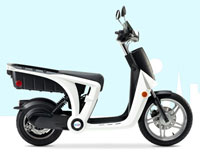 The GenZe 2.0 electric scooter is also Smart-connected that allows for route planning, traffic alerts and weather conditions. Similarly, you can also swap out the batteries when they need recharging, or plug into any standard outlet. It retails at $3,000. (Or you might prefer the GenZe eBike for $1,500 – pedaling optional.) The scooter can hit 30 MPH and has a range of about 30 miles before needing to be recharged. I’m more impressed by the Gogoro, however the GenZe is nice and has one huge, superior feature – it’s available in the U.S.
The GenZe 2.0 electric scooter is also Smart-connected that allows for route planning, traffic alerts and weather conditions. Similarly, you can also swap out the batteries when they need recharging, or plug into any standard outlet. It retails at $3,000. (Or you might prefer the GenZe eBike for $1,500 – pedaling optional.) The scooter can hit 30 MPH and has a range of about 30 miles before needing to be recharged. I’m more impressed by the Gogoro, however the GenZe is nice and has one huge, superior feature – it’s available in the U.S.
Good news, the end is in sight. We’re not quite there yet, there’s still more to go, but you can see the edge of the horizon from here. Hang in there.
Amid all the technical overload, I ran into a cultural oddity at the show – coming across four companies that had been on the TV show, “Shark Tank.” Three were invested in by Mark Cuban, while the other (which I’d written about at CES several years ago before it was on the program) didn’t get any offer – and whimsically it’s the most successful of them all. (In part, that’s because the owner screwed up and forgot the mention the Most Important Feature of the product!)
That company is Ring, which offers a camera monitor outside your front door, and lets you access it from an app on your Smartphone/tablet anywhere in the world. (The owner forgot to mention that part, and all the investors kept saying, “But I can see who’s at my front door already with a door monitor.”) This year, Ring introduced an expanded product that can be set-up anywhere in your house, so you can keep an eye on your kids, pets, security, whatever – from wherever you are in the world.
The other three companies are more in their early stages, but all quite good. The most advanced thus far is Ilumi. The company makes high-end Smart LED lightbulbs. Other companies do, as well – it’s a growing field – but Ilumi’s are quite high end. You can control them by Bluetooth from your house, though not from anywhere, so there’s no turning on your lights at night from the road. But these bulbs are indeed very “smart,” and can change color to whatever your mood fits you. The company also just introduced an outdoor model.
The remaining two companies are still closer to being considered start-ups and both had their displays in the Eureka Park section of the show (more on that in a moment).
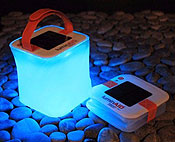 LuminAID is an incredibly noble company with an intriguing solar product, started by two young women. When Haiti was pummeled by an earthquake, the two graduate students developed a cheap, easy source of solar-powered light – basically think of it as blowing up a beach ball that has a solar panel on it, and when charged it glows – and distributed 1,000 of them to the devastated country. (They’ve subsequently done so for other disasters.) The product line has expanded into more form factors, and serves additional uses: being so light and portable, they’re particularly valuable for camping, and also as a backup during a blackout. They tend to retail for around $25.
LuminAID is an incredibly noble company with an intriguing solar product, started by two young women. When Haiti was pummeled by an earthquake, the two graduate students developed a cheap, easy source of solar-powered light – basically think of it as blowing up a beach ball that has a solar panel on it, and when charged it glows – and distributed 1,000 of them to the devastated country. (They’ve subsequently done so for other disasters.) The product line has expanded into more form factors, and serves additional uses: being so light and portable, they’re particularly valuable for camping, and also as a backup during a blackout. They tend to retail for around $25.
I’ve actually reviewed products from Power Practical last year, though not their Power Pot which was what got their “Shark Tank” investment. (It’s a hugely inventive pot for camping that can convert boiling water when cooking into energy that can charge your mobile devices.) Inventiveness in design is their hallmark – so it’s odd that their new product, just released, is so low-end simple and yet may already be their most successful. It’s the Luminoodle. (Are you getting a Cubanic theme here, with lights and lumins?) This is nothing more than a looooooong plastic “rope” with little lights inside that has magnets on each end and a movable magnet in the center. Plug in one end to a portable battery, and you’ll have this snake of light that you can string up in your back yard or a tent, or use the magnets to attach it to the side of your car if you have to pull over at night to repair a tire – or just bunch it all up and stuff it in a sack to become a lantern, whether for camping or during a blackout. It starts at $20, depending on the length.
And that brings us to the finale. Yes! Eureka, we got there. Literally. Eureka Park – this is the area at CES for start-up companies. I’ve rarely written about Eureka Park in the past since it was shunted off in the “secondary” Sands Convention Center, fairly small (taking up maybe three conference rooms) with products you’d likely never come across. It’s grown a bit over the years, and was fairly good-sized last year, encompassing many long rows of booths. But this year – boy, howdy, it exploded. Eureka Park took up almost the entire ground floor of the Sands, covering probably two football fields of companies. Entrepreneurship has gone Bit Time.
As a result, I’ve decided to write a bit of what I came across there. I’m not going to go into much detail, more of a list with simple descriptions, but I think it’s important to get a sense of what was on display. Because though start-ups, there was a real maturity to many of the companies, a good number of which are far beyond the prototype stage, but selling already. Some are extremely interesting – and most are a good try, though limited in scope and probably won’t make it – and far more than a few are “What on earth were you thinking???!” Here’s a cross-section.
Viktor – was very odd, but I sort of liked it. It’s a Smart pillow. Yes, really. But it's for the elderly who might have a hard time dealing with Smartphones, particularly if they spend a lot of time in bed. There is a panel with well-marked pictographs of its features – the On button displays the features on your TV screen, things like video-conferencing with family members, access to medical info, a way to send email, browse the Internet, or play games. It comes from a company that’s part of the large “La French Tech” section at CES.
Spritely – an app for your phone that will go off as an alarm, but won’t stop buzzing until you not only get up but stay out of bed.
Grush – a Smart toothbrush that links with an app to create games for children to make brushing more fun.
IneMotion – this is an inflatable vest, like an airbag you wear, that detects loss of balance to inflate in 100 milliseconds. It’s mainly positioned to protect skiers, but it would be beneficial for construction workers who work on rooftops, or full-time drivers whose cars don’t have airbags. It weighs about 3.5 pounds and is also part of “La French Tech”.
Squire – an app that lets you book and pay for a haircut or shave. No, seriously. That’s it. It’s very well designed, but you just wanted to give the developer a hug to keep trying.
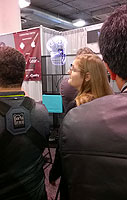 Kino – I don’t know exactly what it’s for, but it had a huge crowd. It creates holograms. I suspect it’s used for advertising. And bizarre as it was, it worked, really well.
Kino – I don’t know exactly what it’s for, but it had a huge crowd. It creates holograms. I suspect it’s used for advertising. And bizarre as it was, it worked, really well.
Cujo – a security service to stop home hacking of your connected devices. It connects to your Wi-Fi router, and is paid for by a monthly charge.
Ampy – this is a portable charger that you wear, which charges itself by motion. The more active you are, the more it charges. Placing it on your leg would get more movement and charge it faster than on your arm. But the developer acknowledges that getting enough stored power to charge a mobile phone would take a long time, so you can also plug it in.
Okto – a Smart ring for your finger that lets you make calls when your phone is still in your pocket. You cup your hand over your ear to talk and listen.
And lots and lot and lots and lots and lots lots lots lots more…
Finally (yes, finally!) that leaves us with my traditional mention of perhaps the oddest product I came across at CES. And no, it’s not the app to reserve a haircut, or the Smart coffee mug, Smart toilet or Smart shoes. So, that should give you an idea of the level we’re going to.
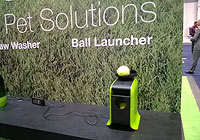 It is the Ball Launcher by O gosh! You use this device to throw tennis balls for your dog to fetch, rather than…oh, gosh, throwing them yourself.
It is the Ball Launcher by O gosh! You use this device to throw tennis balls for your dog to fetch, rather than…oh, gosh, throwing them yourself.
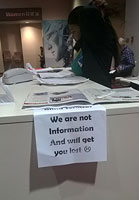 And with that, we’ll bid a fond adieu and a tip of the hat for making it all the way through. That’s the maniacal circus zoo madhouse that is the joyful mess of CES.
And with that, we’ll bid a fond adieu and a tip of the hat for making it all the way through. That’s the maniacal circus zoo madhouse that is the joyful mess of CES.
And we’ll leave you with my favorite sign that I came across at the show. It was at a poor, beleaguered desk providing assistance for people with special needs to get around CES. The desk was well-marked, absolutely clear for all to see that the one thing, the only thing they offered was help for those with a physical disability. Yet all the time, as a massive onslaught of people barreled by non-stop, attendees would think it was a basic Information Desk and pummel the inundated staff with relentless questions that they simply couldn’t and were not remotely equipped to answer. And so, as a last resort out of desperation, they came up with this –
Note: The Writers Guild of America West neither implicitly nor explicitly endorses opinions or attitudes expressed in this article.
Copyright 2016, Robert J. Elisberg. All rights reserved.
Robert J. Elisberg's new novel The Wild Roses, a comic adventure in the spirit of The Three Musketeers but with three women, is now available here in paperback or for $3.99 as a Kindle eBook. His other political and tech writing can be found at Elisberg Industries.
